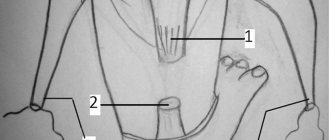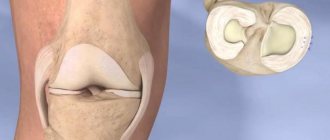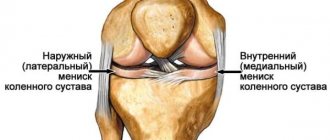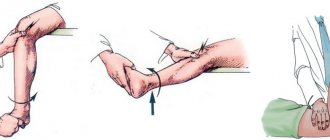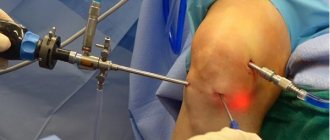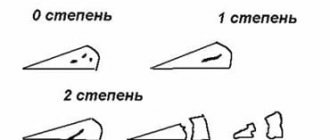The meniscus is one of the significant structural parts of the knee joint, acting as a stabilizer and shock absorber of the knee, a load balancer. The most important organ in this section is not in its only form: it is represented by the medial and lateral bodies. What are they? These are fibrocartilaginous formations on a collagen and elastin basis, characterized by high strength, elasticity and excellent elasticity. The menisci are crescent-shaped and are located between the articulating articular surfaces, separating the femur and tibia. The peculiar cartilages are sometimes called cartilage spacers.
Despite the extreme physiological strength, the meniscal bodies are not immune from damage. And especially from pathological ruptures that can occur due to various knee injuries. Such an unfortunate excess often occurs during sports, with axial physical loads in combination with rotation of the lower leg. Often, to eliminate a cartilage defect, surgery on the meniscus of the knee joint is used, the postoperative period after which has its limitations. If the injury is not serious, then, in principle, it can be treated conservatively. In any case, it is necessary to undergo specialized diagnostics so that competent therapy can be prescribed.
Traumatic ruptures, according to practical observations, occur mainly at the age of 20-30 years, and degenerative ones - after 40 years. In the group of patients with similar pathologies, athletes and males dominate. Statistics show that men are almost 4 times more likely to have problems with the meniscus than women. The cartilage lining can also be damaged under the influence of chronic degenerative-dystrophic processes localized in the knee joint, which is mainly observed in adulthood and old age. Destructured cartilage may well rupture even without a traumatic factor; those who suffer from grade 2-3 gonarthrosis should know about this.
Meniscus treatment - stages
Meniscus treatment - stages
- Carrying out diagnostics, during which the doctor finds out the cause of the violation of integrity, pays attention to the main symptoms of the pathological process, and also prescribes additional research methods with visualization of the knee structures (radiography, ultrasound, computed tomography or magnetic resonance imaging, arthroscopy).
- After analyzing the results of the study, with the help of which the meniscus of the knee is visualized, the operation is selected individually, taking into account a number of factors (the nature and duration of the injury, the anatomical individual characteristics of the patient, his age, the presence of concomitant pathology).
- The preparatory stage before surgery that affects the meniscus of the knee. Treatment is carried out using drugs of various pharmacological groups in order to reduce the severity of the inflammatory reaction, suppress the infectious process, normalize the general condition and adaptive capabilities of the patient's body.
- The main stage of therapeutic measures in which meniscus damage is restored. The operation is performed using various techniques (arthroscopic plastic surgery, open surgery).
- Recovery stage. After knee (meniscus) surgery has been performed, rehabilitation is an important stage that determines the complete restoration of functional activity. Its duration depends on the method of surgical intervention.
In most cases, all stages of therapeutic measures if the meniscus is damaged (surgery, treatment, recovery) are alternated sequentially. Each subsequent stage begins after the previous one has been completed.
Meniscus damaged
The meniscus is damaged.
In most cases, surgery is the only method of radical treatment. The exception is minor damage to the connective tissue fibers of the ligaments without disturbing the general anatomical structure. In this case, conservative therapeutic measures are prescribed, including the use of medications and physiotherapy techniques.
In case of severe violations of integrity, surgery is prescribed to restore the meniscus, its partial (resection) or complete removal. The method of surgical intervention and its volume are determined depending on the nature and location of the injury or pathological process in which the meniscus was damaged. The operation is selected by the doctor individually.
Medial meniscus surgery
The cartilaginous structure of the knee, localized in the area of the inner surface, is quite often subject to injury. Damage occurs due to a direct mechanical blow to the knee or rotation (rotation) of the thigh with a fixed shin. Surgery on the internal meniscus can be performed arthroscopically or through an open approach.
In modern clinics, the method of choice is arthroscopy, which is less traumatic. Its essence lies in introducing a tube with a camera, lighting and micro-instruments into the joint cavity through small incisions, which allows manipulations to be carried out under visual control on a monitor.
If the meniscus is torn, surgery is usually performed using an open approach, as the cartilage structure may need to be completely removed.
Lateral meniscus tear - surgery
The cartilaginous structure, localized in the area of the outer surface of the knee, is damaged less frequently. But at the same time, the severity of the violation of the anatomical integrity is more significant (complete rupture or separation from the ligaments).
In this case, open knee surgery is usually performed. The meniscus, tear or tear is repaired using implants or ligament repair.
Surgery on the cruciate ligament and meniscus
Quite often, traumatic damage to the structures of the knee can be combined, with a violation of the integrity of the cruciate ligaments that stabilize the joint. In such cases, with combined damage to the meniscus on the leg, the operation is performed using an open approach. It is quite complex and requires a longer rehabilitation period necessary to fully restore the strength of the connective tissue fibers of the ligaments.
Meniscus suturing surgery
If there is a slight violation of the anatomical integrity in the form of a crack or rupture with minimal discrepancy, displacement of cartilaginous fragments, arthroscopic surgery is performed. Using microinstruments, the doctor uses special staples to sew the cartilage fragments together to restore the overall anatomical structure.
What are menisci?
Structure of the knee Menisci are fibrocartilaginous structures that give the joint the necessary stability, evenly distribute body weight in the knee and act as a shock absorber.
Each knee has two menisci that look like C-shaped pads. They are located between the tibia and femur, one on the inside of the knee (medial meniscus), the other on the outside (lateral). The medial meniscus is most often affected.
Because menisci are shaped like the letter “C,” they have two so-called horns (the part where the meniscus ends)—anterior and posterior. Most ruptures occur in the dorsal horn.
Meniscus suturing surgery
Surgery to stitch the meniscus.
Regeneration of cartilage tissue is a long process, so rehabilitation is carried out to avoid suture dehiscence. This is important to prevent the need for procedures such as meniscus revision surgery.
If therapeutic measures are carried out correctly to restore meniscus damage, treatment is effective and gives a favorable prognosis for the functional state of the knee. Surgery for a torn meniscus provides a good therapeutic effect and a favorable prognosis.
Surgery to remove part of the meniscus
Removing part of the cartilage structure of the knee is called resection. This is a necessary measure. It is carried out in cases of significant damage in which normal restoration of the anatomical relationship and integrity is impossible. Meniscus resection surgery is usually performed using an arthroscope.
Further therapeutic tactics depend on the volume of tissue removed. It may include a recovery period or replacing the area of removed tissue with special implants. If partial removal was carried out due to an injury such as a torn meniscus, surgery, rehabilitation, and physiotherapeutic procedures are carried out over a sufficiently long period of time.
Causes
Changes in the structure of the internal cartilage of the knee is a polyetiological process that can develop due to the influence of several provoking factors:
- Trauma leading to the implementation of several pathogenetic mechanisms of changes developing in cartilaginous structures. It usually occurs in fairly young people, as well as in athletes - both professionals and amateurs.
- An acquired decrease in the strength of cartilage, which is observed in older people against the background of the development of degenerative changes resulting from impaired nutrition (trophism) of tissues.
- A hereditary change in the properties of cartilage, determined by a violation of the functional state of genes, while changes in integrity can occur in children against the background of low loads for their age (walking, running, squats).
- Inflammation that develops over a relatively long period of time (several years) and partially affects cartilage. It usually occurs against the background of a chronic infection or autoimmune pathology, in which antibodies are produced to body tissues.
Determining the cause of the pathological condition is necessary for adequate etiotropic therapy aimed at eliminating its effects, as well as to prevent similar injuries in the future.
Meniscus removal surgery
Complete removal of anatomical cartilaginous structures is performed when there is significant damage, leading to the formation of a large number of fragments. For small fragments, surgery is performed arthroscopically. If the fragments are of significant size, and there is also a violation of the anatomical integrity of other structures of the knee, then surgical manipulations are performed using an open approach.
After an operation to remove the meniscus has been performed, the doctor immediately decides on the need to replace this cartilaginous structure with an implant. In general, the cost of meniscus removal surgery is higher than other techniques, since it may include a one-stage implantation.
Meniscus replacement surgery
Meniscus replacement surgery
Meniscus replacement surgery
Replacement of the cartilage structure of the knee is carried out after its partial or complete removal. For this purpose, donor biological material or artificial implants are used, which are highly durable and do not lead to the development of an inflammatory reaction and rejection.
Surgery is usually performed using arthroscopy. If it is necessary to perform a significant amount of manipulation, surgery on the meniscus is possible only through open access. When performing an operation to replace a meniscus, the price includes not only the manipulation itself, but also the cost of the implant or donor biological material.
Surgery for old meniscus tear
The lack of timely provision of specialized medical care after a knee injury leads to the formation of calluses in the area of rupture of cartilage structures, which prevent the regeneration of the cartilage tissue that makes up the meniscus. The operation and restoration in this case have certain difficulties associated with the need for preliminary excision of calluses in order to allow their subsequent full regeneration with the restoration of anatomical integrity.
Surgery for minor injuries is performed primarily using arthroscopy.
Meniscus surgery rehabilitation
Diagnosis of knee injury
Acute pain and the serious condition of the patient do not allow one to determine by eye at the time of injury exactly which of the components of the knee joint was damaged. This could be a meniscus, a ligament or a tendon rupture. Symptoms become typical only after 14 days. Until this moment, modern research methods will come to the aid of specialists:
- ultrasound;
- MRI;
- CT.
As first aid, before the ambulance arrives or until the patient is taken to the emergency room, it is necessary to apply ice to the knee and ensure that the limb is immobile.
rehabilitation
rehabilitation
A fairly important stage in the treatment of traumatic injuries to the structures of the knee, on the correct implementation of which the prognosis depends, is rehabilitation after surgery on the meniscus. It includes a number of measures that are aimed at preventing complications (secondary infection, bleeding), as well as the gradual restoration of joint function.
For this, various medications, physiotherapy (magnetic therapy, mud baths, electrophoresis), as well as therapeutic exercises with a gradual increase in the load on the knee are used.
After the meniscus has been removed, rehabilitation is longer and lasts at least six months. If there is a minor injury affecting the meniscus or ligaments, the operation was performed using arthroscopy, then the recovery period will be shorter.
Why is arthroscopy necessary?
Before the widespread use of this technique, the menisci in the joints were simply removed, since it was believed that they were not particularly necessary, the joints could move without them. But this state of affairs did not last long; it is now known that such an operation can easily lead to the development of arthrosis and other complications. That is why nowadays people try not to do such manipulations, replacing them with arthroscopy. In its process, as much of the meniscus as possible is preserved, thereby reducing the risk of complications.
In general, this technique allows you to get rid of pain, inflammation, helps relieve swelling and help a person not to lose motor function in the future. At the same time, muscle function improves. If required, unnecessary and inflamed tissues that interfere with the overall restoration of the joint can be removed.
